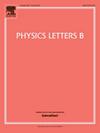邻近双核的螺旋相关性
IF 4.3
2区 物理与天体物理
Q1 ASTRONOMY & ASTROPHYSICS
引用次数: 0
摘要
本文章由计算机程序翻译,如有差异,请以英文原文为准。
Helicity correlation of neighboring dihadron
The spin correlation of final-state hadrons provides a novel platform to explore the hadronization mechanism of polarized partons in unpolarized high-energy collisions. In this work, we investigate the helicity correlation of two hadrons originating from the same single parton. The production of such a dihadron system is formally described by the dihadron fragmentation function, in which the helicity correlation between the two hadrons arise from both the long-distance nonperturbative physics and the perturbative QCD evolution. Beyond the extraction of the dihadron fragmentation function, we demonstrate that it is also a sensitive observable to the longitudinal spin transfer, characterized by the single hadron fragmentation function . This intriguing connection opens up new opportunities for understanding the spin dynamics of hadronization and provides a complementary approach to corresponding studies using polarized beams and targets.
求助全文
通过发布文献求助,成功后即可免费获取论文全文。
去求助
来源期刊

Physics Letters B
物理-物理:综合
CiteScore
9.10
自引率
6.80%
发文量
647
审稿时长
3 months
期刊介绍:
Physics Letters B ensures the rapid publication of important new results in particle physics, nuclear physics and cosmology. Specialized editors are responsible for contributions in experimental nuclear physics, theoretical nuclear physics, experimental high-energy physics, theoretical high-energy physics, and astrophysics.
 求助内容:
求助内容: 应助结果提醒方式:
应助结果提醒方式:


